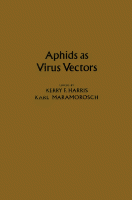Browse content
Table of contents
Actions for selected chapters
- Full text access
- Book chapterNo access
INDEX
Pages 547-559
About the book
Description
Aphids as Virus Vectors focuses on aphids as vectors of plant viruses and the fundamentals of their relationship with virus and host. The mouthparts and feeding mechanism of aphids are discussed, along with aphid penetration of plant tissues and the transmission mechanisms of aphids as virus vectors. The intrinsic properties and taxonomy of aphid-borne viruses are also examined. Comprised of 22 chapters, this book begins with an overview of the importance of aphids as vectors, their biology, and the properties of the viruses they transmit. These introductory chapters prepare the reader for later ones on aphid-virus-plant interactions. The next section deals with transmission mechanisms, with emphasis on several novel alternatives to many of the traditionally held concepts of how aphids transmit viruses. Accessory factors in non-persistent virus transmission are considered. Subsequent chapters focus on technological advances in aphid-virus research, including the use of aphid cell culturing, radioisotope methodology, membrane feeding, and electrical measurement systems. The most promising frontiers in epidemiological and control-oriented research are discussed in the last two sections. This monograph will be a useful resource for researchers from such varied sciences as entomology, plant science, and virology, as well as for graduate students taking entomology and plant pathology courses on insects in relation to plant diseases.
Aphids as Virus Vectors focuses on aphids as vectors of plant viruses and the fundamentals of their relationship with virus and host. The mouthparts and feeding mechanism of aphids are discussed, along with aphid penetration of plant tissues and the transmission mechanisms of aphids as virus vectors. The intrinsic properties and taxonomy of aphid-borne viruses are also examined. Comprised of 22 chapters, this book begins with an overview of the importance of aphids as vectors, their biology, and the properties of the viruses they transmit. These introductory chapters prepare the reader for later ones on aphid-virus-plant interactions. The next section deals with transmission mechanisms, with emphasis on several novel alternatives to many of the traditionally held concepts of how aphids transmit viruses. Accessory factors in non-persistent virus transmission are considered. Subsequent chapters focus on technological advances in aphid-virus research, including the use of aphid cell culturing, radioisotope methodology, membrane feeding, and electrical measurement systems. The most promising frontiers in epidemiological and control-oriented research are discussed in the last two sections. This monograph will be a useful resource for researchers from such varied sciences as entomology, plant science, and virology, as well as for graduate students taking entomology and plant pathology courses on insects in relation to plant diseases.
Details
ISBN
978-0-12-327550-9
Language
English
Published
1977
Copyright
Copyright © 1977 Elsevier Inc. All rights reserved.
Imprint
Academic Press
